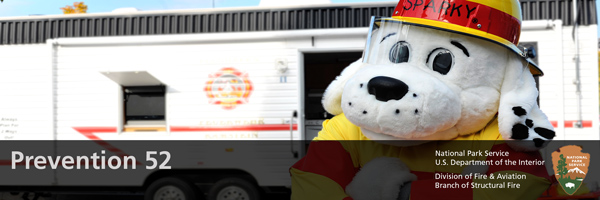
Sparky the Fire Dog has been spreading the message about structural fire safety and prevention to families since 1951. Sparky collaborates with fire departments across the country to communicate what we can do to prevent fires in our homes and workplaces.
The National Park Service is steward to over 32,000 buildings and unique structures. Many are historic, and many are national icons. Our mission demands that structural fire prevention be a priority to protect these priceless resources. NPS employees are in and amongst these structures every day at home and at work. This gives employees and their families the ability to "spot" a fire hazard before a fire starts, to report the hazard, and possibly to save property and lives.
Sparky's fire prevention messages are simple and they work. So this week, we're celebrating Sparky's birthday, and what he can teach the NPS community.
Fire Info for You
Park Structural Fire Coordinators
One of the biggest responsibilities of the park structural fire coordinator (PSFC) is to "sniff out" fire hazards by conducting annual fire and life safety building inspections. This summer, watch for online PSFC training to improve your ability to conduct these important inspections.
Regional/National Leadership
Did you know that DM 485: Chapter 6 requires that managers of bureaus and offices ensure that all locations within their bureau or office are safety inpsected by September 30th of each fiscal year?
Take Action
- Identify your park structural fire coordinator.
- Use Sparky's Family Checklist to "spot" one fire safety concern in your work or home and discuss it with someone who can make the necessary change.
- Share some fun fire prevention materials from Sparky's website http://www.sparky.org/ with your family.
NPS Fire Facts
In 2011, 44 parks had their structural fire programs audited as a part of the A123 process. As a result, the lessons learned and actions taken will significantly decrease the risk of injury or death to employees and park visitors and reduce the chance of losing buildings.
This year, 20% of the national park units will be participating in the A123 audit. We ask that you and your park look at the A123 process not as an unwelcomed audit, but as an opportunity to strengthen your park's structural fire program.
Last updated: October 20, 2016
